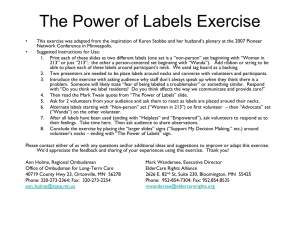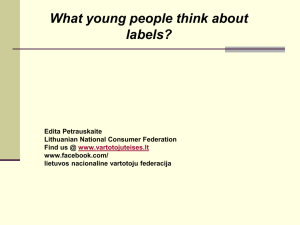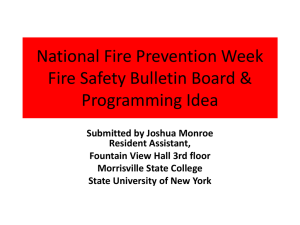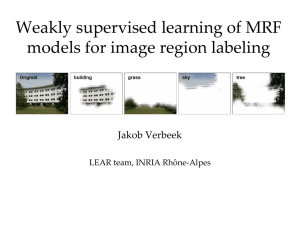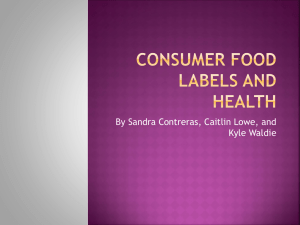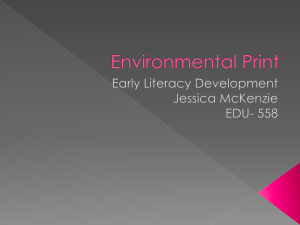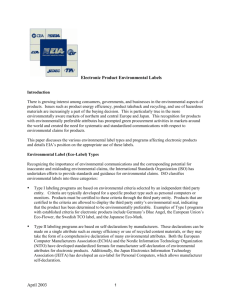Labels and Labeling
advertisement
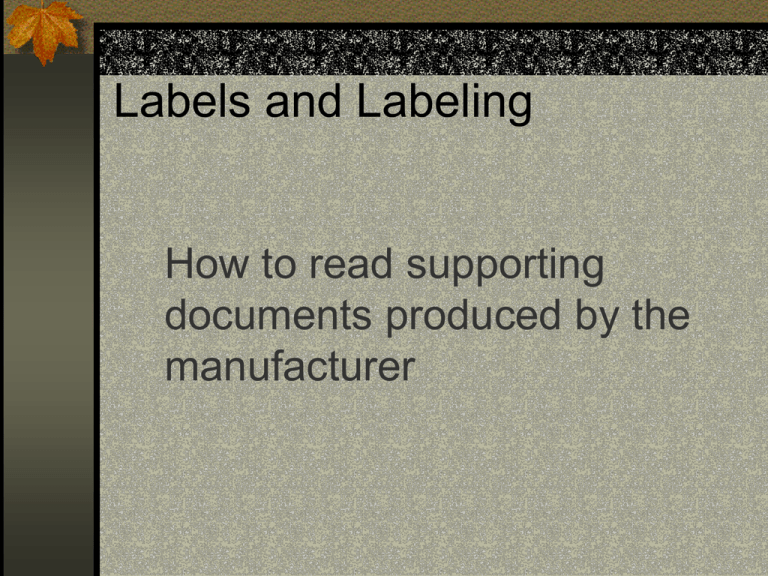
Labels and Labeling How to read supporting documents produced by the manufacturer Labels and Labeling: Labels The label is an EPA required document describing allowable use of a product To the manufacturer it is a license to sell To governments (state & federal) it is a way to control distribution, sale, use, storage, transport, and disposal of the product To the buyer it is the main source of information about how to use the product safely and legally And, to tell the user about any safety measures needed for appropriate use Labels and Labeling: Labels – Required Data Name of product, Signal words and Chemical and common name of the a.i. Ingredient statement including percent of content and type of formulation Name and address of manufacturer EPA registration and establishment numbers symbols Pesticide precautionary statement WPS requirements and precautions Statement of practical treatment Directions for use Plus several other items Label Information on the Web • http://www.dupont.com/ag/us/dfo.htm • http://www.dowagro.com/main/ • http://www.helenachemical.com • http://www.basf.com • http://ag.fmc/index2.html • http://www.gowan.com • http://www.riverdalecc.com/ Collateral pesticide info on the web • http://ace.orst.edu/info/extoxnet/ghindex.htm • http://www.epa.gov/opprd001/factsheets • http://www.cdpr.ca.gov/docs/label/labelque.htm Permissions in FIFRA (Federal Insecticide, Fungicide, and Rodenticide Act) May use pesticide at a rate lower than listed on label May use a pesticide on a target not listed on the label -- as long as the site is listed May apply the pesticide by a method not listed on the label as long as the method is not prohibited on the label FIFRA REQUIREMENTS Site of application must be on the label for proposed use to be legal This leads to some confusion For most herbicides “site” is described as “Sitepreparation”, “Conifer release”, etc. For insecticides “site” often means the target pest such as “Gypsy moth” or “Bark beetles on conifers” FIFRA REQUIREMENTS “It is a violation of federal law to use this product in a manner inconsistent with its labeling” DO NOT memorize label information !!!!! Look at the label at least four times At the time you prescribe its use When the shipment arrives onsite At the tailgate safety session for crews At the time of disposal Example chemical?: Velpar L * Garlon 3A * Garlon 4 * Labels and Labeling: The Velpar L Label We’ll use the Velpar L (hexazinone) label for most of this discussion Note that herbicide labels are among the easiest to read (Monsanto’s and the companies which have bought repackaging rights to former Monsanto products are the exception) Table of Contents Formulator Product name WPS Precautions Statement of Ingredients EPA Registr # Signal words & human health precautions General information Not from the example label this “DANGER - POISON” notice is required when appropriate (LD50 of 50 of or less) Return to Garlon 3A or Garlon 4 label Next slide in presentation * Labels and Labeling: The Garlon 3A Label We’ll use the Garlon 3A (triclopyr) label for most of this discussion Note that herbicide labels are among the easiest to read (Monsanto’s and the companies which have bought repackaging rights to former Monsanto products are the exception) “DANGER – POISON” Example * Next Slide in presentation Labels and Labeling: The Garlon 4 Label We’ll use the Garlon 4 (triclopyr) label for most of this discussion Note that herbicide labels are among the easiest to read (Monsanto’s and the companies which have bought repackaging rights to former Monsanto products are the exception) “DANGER – POISON” Example * Labels and Labeling: Supplemental labels Additional sites of allowable use Supplemental labels are easier to generate than a new label But, information from supplemental labels will be incorporated in the next version of the label issued If the use is maintained Labels and Labeling: The MSDS (Material Safety Data Sheet) Content (specific subjects) is now specified and required by the EPA Categories of information are defined so the information should be easy to find Some older MSDSs are still are available and are often hard to interpret Labels and Labeling: Note about Aquatic Labels Computation of water volumes often gives applicators trouble Concept of acre foot (see aquatic label section) is confusing So, most aquatic labels include a calibration table based on desired application rate and dimensions of the water body Label revocation Canceled A specific use is no longer allowed by newer labeling – but products with that use listed on them may be used Like a postage stamp – used as originally permitted Suspended Specified uses are no longer permitted regardless of package label Think of a hanging – suspended uses are dead Labels and Labeling: Labeling Supporting information Produced by the manufacturer Gives technical, environmental, or application (rate or tool) information Calibration guides Product info: American Cyanamid Product info Dow Product info DowElanco Product info DuPont Product info Monsanto Product info NovArtis
